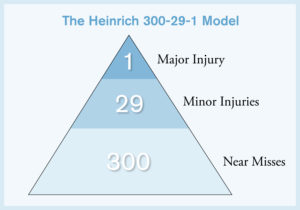January 1, 2018
Does Focusing on SIFs Mean Ignoring Smaller Injuries?
In our book “7 Insights into Safety Leadership,” Tom Krause and I make the point that leaders should start with a focus on preventing serious injuries and fatalities (SIFs). What does it mean to focus on SIFs? What doesn’t it mean? Why is a SIF focus better?
First, A Clarification
Focusing on SIFs does not mean that smaller injuries are unimportant. It does not mean they should be ignored or left out. Instead, focusing on SIFs is an optimal strategy for preventing all injuries. It is a new approach, and some who have been taught that the best prevention strategy is to focus on the larger category of all injuries and near misses (the bottom of the triangle) could find this confusing. But the data clearly show that the age-old bottom-up “safety triangle” strategy is not optimal. Failing to differentiate between exposure to smaller injuries and exposures to SIFs opens the door to tragic outcomes. It undermines the credibility of leadership and it misuses limited resources.
Not everyone agrees. One objection I hear is, “We believe that any harm is too great and we will never give up on preventing even the smallest injury.” For sure, the goal is to prevent all injury. The question is, what is the most effective way to do it?
The Research

Heinrich showed that the most severe injuries are the least common, and that the least severe injuries are the most common (see above). This inverse relationship between frequency and severity has been verified over and over again. But Heinrich also concluded that efforts to reduce injuries at the bottom of the triangle would naturally prevent the rare but severe injuries at the top of the triangle. A 2011 study conducted by Tom Krause, our colleagues at BST, and others showed that this conclusion is false. Analyzing data from seven different organizations showed that about 1 in 5 incidents have the potential to result in a life-altering or fatal injury. So reducing the broad base of injuries by say 20% would mean reducing SIFs by 4% on average. Further, the study found that the situations, activities, and root causes of SIFs were different than those of the smaller injuries.
The Implications
We need to integrate this new knowledge into our organizational systems, leadership, safety programs, and measures. Leading organizations have already started, and some are demonstrating great results.
This is great news to those who have dedicated their professional lives to safety. No safety professional or operations leader would intentionally deter SIF prevention. But over the past 15 years, as organizations have achieved lower and lower recordable injury rates, serious or fatal injuries have not kept pace. Improvement in fatal injury rates has tapered off. Some industries such as mining, agriculture, and manufacturing have seen fatality rates increase. This is extremely distressing and it demands the attention of safety leaders across the world.
We want to see all injuries declining at least proportionally. If anything, SIFs should decline faster than smaller injuries. But it isn’t a “choose one” scenario. Rather, we want a strategy that will do both. This means incorporating the new thinking into your entire organization, from the senior most leaders to the newest front line employee.
A Simple Solution
Experience has shown that measuring and reporting on a key issue will stimulate change for the better. It’s a simple solution. Senior leaders can bring it about by asking about the SIF potential in their organizations. How much is there? Are we getting better? Where is our exposure greatest? They can also ask about SIF precursors. Precursors are combinations of situations, tasks, contextual variables that have a disproportionate chance of resulting in a SIF in your organization. Each organization is unique, and a great deal can be learned just from understanding what yours are.
Most organizations already have excellent measurement systems to capture exposure data, near misses, first aid cases, and reportable injuries and illnesses. We’re not proposing getting rid of any of that, unless your data are deficient in some way that can’t be fixed. Instead, we advocate that leaders start looking at the SIF precursors in their organizations. This will naturally lead to improvements in the safety systems, culture, and leadership efforts.
It takes a bit of effort, but it is entirely achievable. And it will save lives.
For Further Information
- Read more about this topic in Chapter 2 of our book, 7 Insights into Safety Leadership.
- Contact us to discuss your situation.


